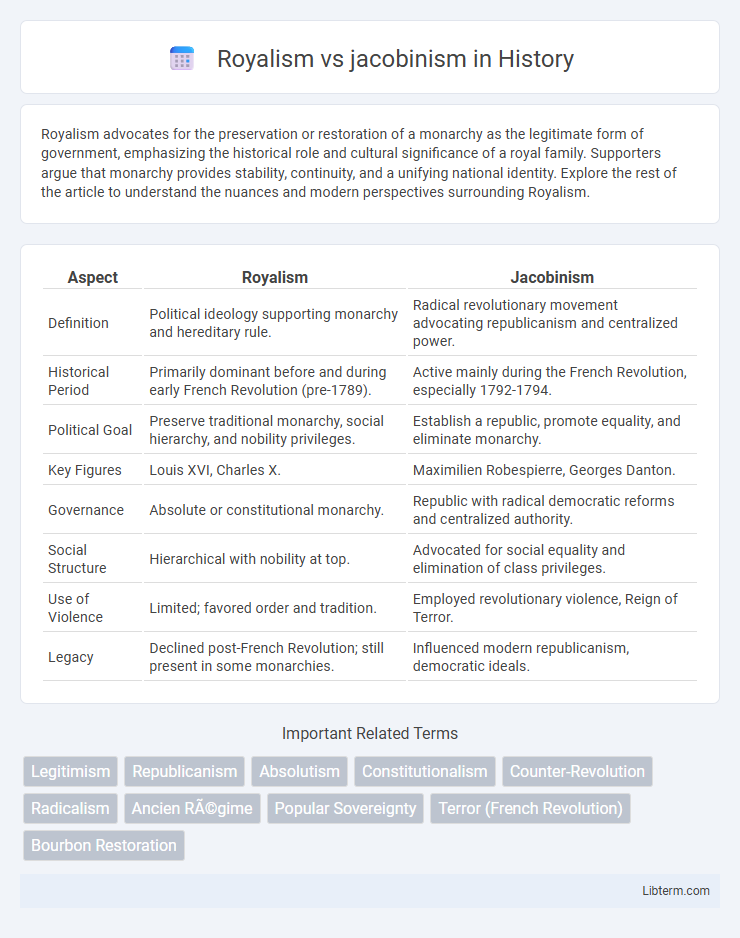Royalism advocates for the preservation or restoration of a monarchy as the legitimate form of government, emphasizing the historical role and cultural significance of a royal family. Supporters argue that monarchy provides stability, continuity, and a unifying national identity. Explore the rest of the article to understand the nuances and modern perspectives surrounding Royalism.
Table of Comparison
| Aspect | Royalism | Jacobinism |
|---|---|---|
| Definition | Political ideology supporting monarchy and hereditary rule. | Radical revolutionary movement advocating republicanism and centralized power. |
| Historical Period | Primarily dominant before and during early French Revolution (pre-1789). | Active mainly during the French Revolution, especially 1792-1794. |
| Political Goal | Preserve traditional monarchy, social hierarchy, and nobility privileges. | Establish a republic, promote equality, and eliminate monarchy. |
| Key Figures | Louis XVI, Charles X. | Maximilien Robespierre, Georges Danton. |
| Governance | Absolute or constitutional monarchy. | Republic with radical democratic reforms and centralized authority. |
| Social Structure | Hierarchical with nobility at top. | Advocated for social equality and elimination of class privileges. |
| Use of Violence | Limited; favored order and tradition. | Employed revolutionary violence, Reign of Terror. |
| Legacy | Declined post-French Revolution; still present in some monarchies. | Influenced modern republicanism, democratic ideals. |
Understanding Royalism: Core Principles
Royalism centers on the belief in a hereditary monarchy as the legitimate and stable form of governance, emphasizing loyalty to the crown and preservation of traditional social hierarchies. It advocates for the divine right of kings, supporting monarchy as a source of order, continuity, and national identity. Royalists often resist radical social and political reforms, favoring gradual change within established institutions to maintain societal stability.
The Rise of Jacobinism in Revolutionary France
The rise of Jacobinism in Revolutionary France marked a radical shift from Royalism, emphasizing republican ideals and popular sovereignty over monarchical authority. Jacobins, led by figures like Robespierre, championed the abolition of the monarchy and the establishment of a democratic republic through decisive political action and the Reign of Terror. This rise was fueled by widespread discontent with the ancien regime, economic hardship, and the desire for egalitarian social reforms that contrasted sharply with Royalist loyalty to the French crown.
Key Differences: Royalist and Jacobin Ideologies
Royalist ideology upholds the authority of monarchy, emphasizing tradition, hierarchy, and the divine right of kings, advocating for political stability through centralized royal power. Jacobin ideology champions republicanism, radical egalitarianism, and popular sovereignty, promoting revolutionary change to dismantle aristocratic privilege and establish a more democratic society. The core divergence lies in Royalists favoring inherited authority and social order, while Jacobins prioritize political equality and active citizen participation in governance.
Historical Context: Monarchy vs. Republicanism
Royalism and Jacobinism represent opposing political ideologies rooted in the historical context of the French Revolution. Royalism advocates for the preservation of the monarchy, emphasizing hereditary rule and traditional social hierarchy as stabilizing forces in society. In contrast, Jacobinism promotes republicanism, championing popular sovereignty, radical social reform, and the dismantling of royal authority to establish a government based on equality and secularism.
Influential Leaders of Royalism and Jacobinism
Influential leaders of Royalism include King Louis XVI, whose reign and eventual execution symbolized the monarchy's decline, and figures like Jacques-Benigne Bossuet, who advocated for the divine right of kings. In contrast, Jacobinism was driven by radical revolutionaries such as Maximilien Robespierre, whose leadership of the Committee of Public Safety led to the Reign of Terror, and Jean-Paul Marat, known for his fiery journalism and influence on popular revolutionary sentiment. These leaders shaped their respective movements through ideological commitment and decisive actions during the French Revolution.
Political Strategies and Methods of Both Movements
Royalism emphasized preserving monarchical authority through loyalty-driven networks and hierarchical control, employing traditional ceremonies and legal institutions to legitimize power. Jacobinism utilized radical political mobilization, including widespread use of propaganda, mass assemblies, and revolutionary tribunals to dismantle the ancien regime and enforce republican ideals. Both movements strategically harnessed ideological narratives to consolidate support and suppress opposition during the French Revolution.
Social Impact: Royalist and Jacobin Policies
Royalist policies emphasized preserving traditional social hierarchies and aristocratic privileges, which maintained stability for the nobility but limited social mobility for commoners. Jacobin policies aggressively promoted egalitarianism through radical reforms, including land redistribution and the suppression of the nobility, which fundamentally altered social structures and empowered lower classes. The Jacobin approach fostered widespread social upheaval and increased political participation among previously marginalized groups, contrasting sharply with the conservative nature of Royalist governance.
Legacy of Royalism and Jacobinism in Modern Politics
Royalism's legacy in modern politics is evident in constitutional monarchies where monarchs hold symbolic authority, reinforcing national identity and continuity. Jacobinism influences contemporary radical leftist movements emphasizing centralized power and revolutionary change to achieve egalitarian social orders. Both ideologies continue to shape debates on governance, authority, and the balance between tradition and reform in modern political systems.
Famous Conflicts and Rebellions Between Factions
The conflict between Royalism and Jacobinism peaked during the French Revolution, notably in the armed clashes of the Vendee Rebellion (1793-1796), where Royalist insurgents opposed the radical Jacobin government's anti-monarchical policies. The September Massacres, driven by Jacobin paranoia against Royalist sympathizers, further intensified factional violence in Paris. These famous rebellions and street battles symbolized the deep ideological divide, with Royalists seeking to restore the Bourbon monarchy while Jacobins aimed to establish a democratic republic anchored in revolutionary ideals.
Contemporary Reflections: Royalism vs. Jacobinism Today
Royalism today often emphasizes tradition, hierarchical governance, and preservation of cultural heritage, appealing to those wary of rapid sociopolitical change. Jacobinism, rooted in radical egalitarianism and revolutionary ideals, influences contemporary movements advocating for systemic reforms and social justice. The ongoing tension between these ideologies reflects broader debates on authority, democracy, and the pace of societal transformation in modern political discourse.
Royalism Infographic

 libterm.com
libterm.com